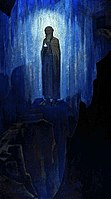Agni Yoga
| Agni Yoga | |
|---|---|
| Founders | Theosophy (Blavatskian) |

Agni Yoga (
Agni Yoga is a path of practice in daily life. It is the
The most significant features of Agni Yoga are cosmism and universalism. They are expressed in the interpretation of any phenomena of human existence from the point of view of their cosmic significance and interrelation with the being of the universe.
Agni Yoga played a significant role in bringing knowledge of
Birth of the new religion
Etymology and concept
Agni Yoga is a synthesis of all yogas. In all the ancient Hindu scriptures the approaching Fiery Epoch has been predicted. It is said that Agni – the Fire that is found in varying degrees at the foundation of all yogas will saturate the atmosphere of our planet tremendously, and all the branches of yoga will be fused into a fiery synthesis. Verily, Agni Yoga is a fiery baptism.
The term Agni Yoga means "mergence with fire" in Sanskrit. This term was introduced to the Western public by Nicholas Roerich and Helena Roerich.[3]
Ur or Aditi (Sanskrit: अदिति "limitless"),[12] in the Vedas and Living Ethics is the mother of the gods and all twelve zodiacal spirits from whose cosmic matrix the heavenly bodies were born. As celestial mother of every existing form and being, the synthesis of all things, she is associated with space and with mystic speech. She is mentioned nearly eighty times in the Rigveda: the verse "Daksha sprang from Aditi and Aditi from Daksha" is seen by Theosophists as a reference to "the eternal cyclic re-birth of the same divine essence" and divine wisdom.[13] "Ur is the root of the Light of Fire", it is stated in the holy writ of Agni Yoga.[14]

The creation of the human form is regarded as the highest cosmic task.
—Infinity Part I, § 387[18]
It is a most heinous treason to know the Teaching and not apply it.
— Agni Yoga, § 98[19]
Tara Urusvati (The Light of the Morning Star) is the spiritual name of Helena Roerich (1879–1955) in Agni Yoga and Roerichism.[25] She was a teacher and healer as well as the inspired co-author of the Agni Yoga series of books, the first English books about Living Ethics and the Roerichs' relationship with their guru.[26] Each of the 935 paragraphs of the book "Supermundane" begins with the word "Urusvati".[27] In the epilogue of the book "Agni Yoga" she is called the Mother of Agni Yoga.[28]
Fuyama is the spiritual name of Nicholas Roerich (1874–1947) in Agni Yoga and Roerichism. He was an internationally acclaimed artist, conservationist, archeologist, humanitarian and peacemaker.[29] Nicolas Roerich called Urusvati "She Who Leads" in his creations.[30]
The concept of spiritual evolution is also complemented by the idea of a
Agni Yoga, in general, is a Neo-Theosophical religious doctrine[35] transmitted by the Helena and Nicholas Roerichs from 1920. The followers of Living Ethics believe that the teaching was given to the Roerichs' family[36] and their associates by Master Morya, the guru of Roerichs and Helena Blavatsky, one of the founders of the modern Theosophical movement and the Theosophical Society.[37] The Teaching of Life is a path of practice in daily life. It is the yoga of fiery energy, of consciousness, of responsible, directed thought. It teaches that the evolution of the planetary consciousness is a pressing necessity and that, through individual striving, it is an attainable aspiration for mankind.[38]
The most significant features of Agni Yoga are cosmism and universalism. They are expressed in the interpretation of any phenomena of human existence from the point of view of their cosmic significance and interrelation with the being of the Universe.[39]
Precursors of Agni Yoga

"The
esotericism."
—Scholar of esotericism Wouter Hanegraaff, 1997.[40]
Theosophy
The Theosophical Society was officially formed in New York City on 17 November 1875 by Helena Blavatsky, Henry Steel Olcott, William Quan Judge, and others. It was self-described as "an unsectarian body of seekers after Truth, who endeavour to promote Brotherhood and strive to serve humanity". After a few years Olcott and Blavatsky moved to India and established the International Headquarters at Adyar, in Madras.[41]
Madame Blavatsky (Upasica – this spiritual name means a female lay disciple. So the "Teachers" called her
Theosophical organisations regard it as a system that embraces what they see as the "essential truth" underlying religion, philosophy, and science. Theosophical groups allow their members to hold other religious allegiances, resulting in Theosophists who also identify as
The term Neo-Theosophy was coined by Ferdinand T. Brooks around 1912. This term used by the followers of Helena Blavatsky to denominate the system of theosophical ideas expounded following the death of Blavatsky in 1891. This material differed in major respects from Blavatsky's original presentation, but it is accepted as genuinely Theosophical by many Theosophists around the world.[45] Daryl S. Paulson associates "Neo-Theosophy" with Alice Bailey.[46] She introduced the term New Age – Age of Aquarius.[47]
Other Neo-Theosophists include Rudolf Steiner's contemporary Peter Deunov, and Samael Aun Weor. Dion Fortune and Aleister Crowley were also influencers of the leading edge of the Theosophical movement. Some examples of Neo-Theosophists today include Benjamin Creme[48] and Victor Skumin. So, in 1990, Skumin, based on the theosophical concept of spiritual evolution, proposed a classification of Homo spiritalis (Latin: "Spiritual man"), the sixth root race, consisting of eight sub-races (subspecies): HS-0 Anabiosis spiritalis, HS-1 Scientella spiritalis, HS-2 Aurora spiritalis, HS-3 Ascensus spiritalis, HS-4 Vocatus spiritalis, HS-5 Illuminatio spiritalis, НS-6 Creatio spiritalis, and HS-7 Servitus spiritalis.[49]
Russian philosophy and Russian Cosmism

Russian
The discussion of Russia's place in the world has since become the most characteristic feature of Russian philosophy. Notable philosophers of the late 19th and early 20th centuries include Vladimir Solovyev, Vasily Rozanov, Lev Shestov, Leo Tolstoy, Sergei Bulgakov, Pavel Florensky, Pitirim Sorokin. In its further development, Russian philosophy was also marked by deep connection to literature and interest in creativity, society, religion, and Russian cosmism.[51]
Vladimir Solovyov described his encounters with the entity Sophia in his works, such as Three Encounters and Lectures on Godmanhood. His fusion was driven by the desire to reconcile or unite with Orthodox Christianity the various iterations of the Russian

At the beginning of the 20th century, there was a burst of scientific investigation into interplanetary travel, largely driven by fiction writers such as Jules Verne and Herbert Wells as well as philosophical movements like Russian cosmism. In 1903, Konstantin Tsiolkovsky published the first serious scientific work on space travel. His work was essentially unknown outside the Russian Empire, but inside the country it inspired further research, experimentation and the formation of the Society for Studies of Interplanetary Spaceflight.[54] Tsiolkovsky wrote a book called "The Will of the Universe; Unknown Intelligent Forces" in which he propounded a philosophy of panpsychism. He believed humans would eventually colonize the Milky Way. His thought preceded the Space Age by several decades, and some of what he foresaw in his imagination has come into being since his death. Tsiolkovsky did not believe in traditional religious cosmology, but instead he believed in a cosmic being that governed humans.[55]
The ideas of the Russian philosophers and cosmists later were developed by those in the transhumanist movement and Roerichism.[56][57] For example, the Russian scientist Victor Skumin argues that the Culture of Health will play an important role in the creation of a human spiritual society into the Solar System.[58][59]
Historical development

Information about
When Nicholas Roerich died, his wife is believed to have carried on the work prescribed by Master Morya, "I exist only due to the ray of the Great Master, who said it was necessary for me to remain because no one could replace me as I worked under the highest Cosmic Sign, and this century was in need of my attainment". The main aim of Helena Roerich was to spread the message of Agni Yoga.[64]
The Agni Yoga Society in the State of New York
The Agni Yoga Society was founded in 1920 by Helena and Nicholas Roerich. It is a non-profit educational institution incorporated in 1946 under the laws of the
Unlike previous yogas, Agni Yoga is a path of practice in daily life. It is the yoga of fiery energy, of consciousness, of responsible, directed thought. It teaches that the evolution of the planetary consciousness is a pressing necessity and that, through individual striving, it is an attainable aspiration for mankind. Though not systematized in an ordinary sense, it is a teaching that helps the student to discover moral and spiritual guide-posts by which to learn to govern his or her life and thus contribute to the common good. For this reason Agni Yoga has been called a "Living Ethics". Speaking about the role of personality in the spiritual evolution of mankind, Helena Roerich wrote:[66][67]
The greatest benefit that we can contribute consists in the broadening of consciousness, and the improvement and enrichment of our thinking, together with the purification of the heart, in order to strengthen our emanations; and by thus raising our vibrations, we restore the health of all that surrounds us. True, it is impossible to increase our store of psychic energy without the help of the Teacher; however if our hearts are open and purified, and if our organism permits it, the Teacher will not tarry in manifesting himself.
Latvian Roerich Society in Riga
The Latvian Roerich Society is one of the oldest society established by the Roerich family. In 1920 Vladimir Schibayev, while being in London, met Nicholas and Helena Roerich. In Riga they created a group of people to study Agni Yoga and other theosophical literature. In 1928, Schibayev went to India, to become the secretary of Roerich.[68]
In Riga the place of the leader of Latvian Roerich Society was taken by
In 1936
Master Institute of United Arts in New York City
Nicolas Roerich is known as a thinker and a builder of life. His art and writings are an evocation to beauty, knowledge, and culture. His vision is captured in his philosophical statement of the Master Institute of United Arts which he formed in New York City in 1921:[70]
Art will unify all humanity. Art is one – indivisible. Art has its many branches, yet all are one. Art is the manifestation of the coming synthesis. Art is for all.
Louis L. Horch and Nettie S. Horch financed and directed the Master Institute that taught the fine and dramatic arts. For much of its existence, the Master Institute was housed in the Master Apartments, designed by Harvey Wiley Corbett in 1929 for Roerich and built on the site of the former Horch mansion at 310 Riverside Dr. in New York City.[71]
Roerich planned to realize the educational concepts at the institute. He invited as teachers such famous people as
Some contemporaries were skeptical spiritual mission of Nicholas Roerich. But those who embraced his philosophy experienced something transformative in his canvases. Roerich's name is universally known not only as a master of the brush but also as a thinker and a builder of life. The works of the artist are an evocation to beauty, knowledge, and culture.[74]
Himalayan Research Institute named Urusvati in India
Roerich's family moved to India in December 1923. They settled in Darjeeling, a town in the Indian state of West Bengal. It is located in the Lower Himalayan Ranges at an elevation of 6,700 ft (2,042.2 m).[76]
From 1925 to 1928, Roerich took part in a

The plethora of materials collected during the Central Asia Expedition became the foundation for the establishment of the Himalayan Research Institute named Urusvati in
The center engaged in scientific exchange with 285 institutes, universities, museums, and libraries around the world. George de Roerich was a world-renowned scientist, Orientalist, and guru.[80] His monumental translation of the Blue Annals (Tibetan: དེབ་ཐེར་སྔོན་པོ),[81] and his 11-volume "Tibetan-Russian-English dictionary with Sanskrit parallels" were published in 1934.[82]
One of his main focuses for the center was to bring people to the institute who practiced and lived the cultures being examined at the center. George Roerich was the director of the Himalayan Research Institute named Urusvati for 10 years.[83]

The work of the Himalayan Research Institute was based on wide international cooperation.
The Journal of the Urusvati Himalayan Research Institute (U.J.) published articles on various aspects of science and culture. The publications presented a multi-level perception of the authors who were looking for a new integration of different cultural models into the mainstream of Agni Yoga.[87]


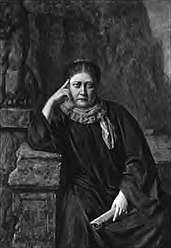



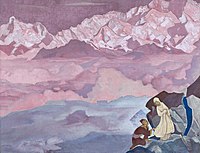

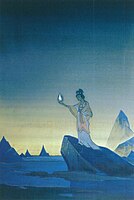
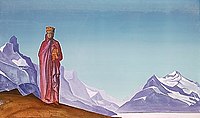

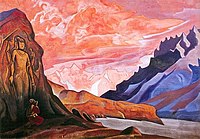

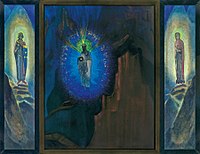
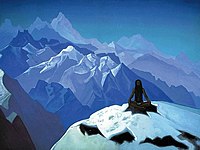


![Nicholas Roerich. Bhagavan Ramakrishna.[113] Between 1930 and 1945](http://upload.wikimedia.org/wikipedia/commons/thumb/c/cb/Blagoslovennaj_dusha.jpg/200px-Blagoslovennaj_dusha.jpg)
![Nicholas Roerich.Command of Rigden Djapo. 1924.[114]](http://upload.wikimedia.org/wikipedia/commons/thumb/6/6d/Command_of_Rigden_Djapo.jpg/200px-Command_of_Rigden_Djapo.jpg)
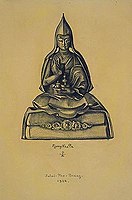

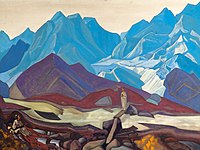

![Nicholas Roerich. Mother of the World.[115] 1924](http://upload.wikimedia.org/wikipedia/commons/thumb/6/6f/Mother_of_the_World.jpg/134px-Mother_of_the_World.jpg)

